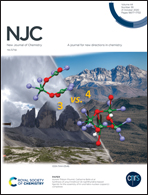Novel garnished cobalt(ii) phthalocyanine with MWCNTs on modified GCE: sensitive and reliable electrochemical investigation of paracetamol and dopamine†
Abstract
The novel synthesis of tetra 1-benzyl-1H-pyrazol-3-carboxamide cobalt(II) phthalocyanine (CoTBPCAPc) was characterized by various spectroscopic methods such as IR, UV-Vis, powder-XRD, mass spectroscopy, and TG analysis. An original electrochemical sensor for the sensitive detection of paracetamol (PA) and dopamine (DA) was developed by drop casting a mixture of processed CoTBPCAPc with composite MWCNTs on a glassy carbon electrode. The as-prepared sensor was studied by cyclic voltammetry, differential pulse voltammetry, chrono-amperometry, and impedance spectroscopy. The peak currents of PA and DA significantly increased as compared to those obtained with bare glassy carbon electrodes or unprocessed MWCNT-modified electrodes. The PA and DA peaks were well defined and evidently separated from each other. This electrochemical sensor shows excellent performance for detecting PA and DA in linear ranges of 50 to 750 nmol L−1, with a detection limit of 17 and 19 nmol L−1 (S/N = 3), respectively, a reproducibility of 5.1% relative standard deviation, and a satisfactory recovery from 97.4% to 103.3%. The sensor shows great promise for simple, sensitive, and quantitative detection and screening of PA and DA. Finally, the sensor was applied in the detection of PA and DA in commercial and urine samples, with satisfactory results.



 Please wait while we load your content...
Please wait while we load your content...